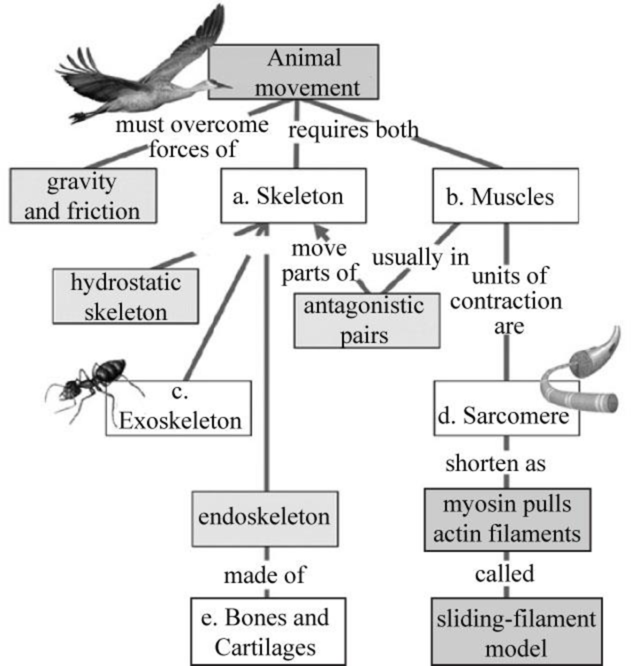
Concept explainers
Complete this concept map on animal movement.

To complete: The given map showing the animal movement.
Introduction:
Movement is a distinguishing characteristic of animals. Even animals that are attached to a substrate move their body parts. All types of animal movement have underlying similarities. At the cellular level, every form of movement involves protein strands moving against one another, an energy-consuming process.
Explanation of Solution
Pictorial representation:
Fig. 1 shows the completed map of the animal movement.

Fig. 1: Completed map of the animal movement
(a)
Correct answer: Skeleton.
Movement in animals requires both the skeleton as well as the muscle. There are many types of skeletons present among the various organisms, which include the endoskeleton, exoskeleton, and hydrostatic skeleton. Each skeleton is associated with different types of movement, such as, flying, walking, running, crawling, and others. Hence, the correct answer is skeleton.
(b)
Correct answer: Muscles.
In every organism, muscles are required to generate a required amount of energy, whether walking, running, swimming, or flying. Hence, the correct answer is muscles.
(c)
Correct answer: Exoskeleton.
The skeletons found among the diverse group of organisms are categorized into three types, which include the endoskeleton, hydrostatic skeleton, and exoskeleton. The exoskeleton is primarily found in the insects. Hence, the correct answer is exoskeleton.
(d)
Correct answer: Sarcomere.
Sarcomeres are the units of muscle contraction; they are found in the striated muscles and are present between 2-Z lines as a repeating unit. Hence, the correct answer is sarcomere.
(e)
Correct answer: Bones and Cartilages.
Endoskeletons are present inside the body and made up of bones and cartilages. Usually, all the vertebrates have a skeleton type as an endoskeleton. Hence, the correct answer is bones and cartilages.
Want to see more full solutions like this?
Chapter 30 Solutions
CAMP.BIO:CONC...MOD.MAST+PRINT>I<
- Describe the levels of structural hierarchy for the human body, starting with the organismal level and ending with the chemical level. In addition, you should make sure you link each level to the previous level, emphasizing the structural relationships.arrow_forward9 S es Read the section "Investigating Life: In (Extremely) Cold Blood." Then, drag and drop the terms on the left to complete the concept map. Red blood cells Genes Icefishes -have mutated have colorless Oxygen have few lack encode Blood Cellular respiration consists of- contain carries is a Platelets White blood cells carries low amounts of Hemoglobin is necessary for Plasma Protein Reset.arrow_forwardPlating 50 microliters of a sample diluted by a factor of 10-6 produced 91 colonies. What was the originalcell density (CFU/ml) in the sample?arrow_forward
- Every tutor here has got this wrong, don't copy off them.arrow_forwardSuppose that the population from question #1 (data is in table below) is experiencing inbreeding depression (F=.25) (and no longer experiencing natural selection). Calculate the new expected genotype frequencies (f) in this population after one round of inbreeding. Please round to 3 decimal places. Genotype Adh Adh Number of Flies 595 Adh Adh 310 Adhs Adhs 95 Total 1000 fladh Adh- flAdn Adh fAdhs Adharrow_forwardWhich of the following best describes why it is difficult to develop antiviral drugs? Explain why. A. antiviral drugs are very difficult to develop andhave no side effects B. viruses are difficult to target because they usethe host cell’s enzymes and ribosomes tometabolize and replicate C. viruses are too small to be targeted by drugs D. viral infections usually clear up on their ownwith no problemsarrow_forward
- This question has 3 parts (A, B, & C), and is under the subject of Nutrition. Thank you!arrow_forwardThey got this question wrong the 2 previous times I uploaded it here, please make sure it's correvct this time.arrow_forwardThis question has multiple parts (A, B & C), and under the subject of Nutrition. Thank you!arrow_forward
- Calculate the CFU/ml of a urine sample if 138 E. coli colonies were counted on a Nutrient Agar Plate when0.5 mls were plated on the NA plate from a 10-9 dilution tube. You must highlight and express your answerin scientific notatioarrow_forwardDon't copy off the other answer if there is anyarrow_forwardAnswerarrow_forward
 Biology: The Dynamic Science (MindTap Course List)BiologyISBN:9781305389892Author:Peter J. Russell, Paul E. Hertz, Beverly McMillanPublisher:Cengage Learning
Biology: The Dynamic Science (MindTap Course List)BiologyISBN:9781305389892Author:Peter J. Russell, Paul E. Hertz, Beverly McMillanPublisher:Cengage Learning Human Physiology: From Cells to Systems (MindTap ...BiologyISBN:9781285866932Author:Lauralee SherwoodPublisher:Cengage Learning
Human Physiology: From Cells to Systems (MindTap ...BiologyISBN:9781285866932Author:Lauralee SherwoodPublisher:Cengage Learning
 Human Biology (MindTap Course List)BiologyISBN:9781305112100Author:Cecie Starr, Beverly McMillanPublisher:Cengage Learning
Human Biology (MindTap Course List)BiologyISBN:9781305112100Author:Cecie Starr, Beverly McMillanPublisher:Cengage Learning Biology Today and Tomorrow without Physiology (Mi...BiologyISBN:9781305117396Author:Cecie Starr, Christine Evers, Lisa StarrPublisher:Cengage Learning
Biology Today and Tomorrow without Physiology (Mi...BiologyISBN:9781305117396Author:Cecie Starr, Christine Evers, Lisa StarrPublisher:Cengage Learning Biology 2eBiologyISBN:9781947172517Author:Matthew Douglas, Jung Choi, Mary Ann ClarkPublisher:OpenStax
Biology 2eBiologyISBN:9781947172517Author:Matthew Douglas, Jung Choi, Mary Ann ClarkPublisher:OpenStax





